Improvement in Durability and Service of Asphalt Pavements through Regionalization Methods: A Case Study in Baja California, Mexico
Abstract
:1. Introduction
2. Background
3. Materials and Methods
3.1. Study Area
3.2. Methodological Description
3.2.1. Type Structures Determination for Asphalt Pavements
3.2.2. Performance Grade Regionalization (PG, for Its Acronym in English) of Asphalt Cement
3.2.3. Economic Impact of Durability on Asphalt Pavements
- (1)
- New DCs, these are calculated through maximum permissible axles loads conditions, stipulated in the NOM-012-SCT-2-2014 regulation and by the common tires inflation pressures in Baja California.
- (2)
- DC 1978, these are established in appendix E of publication no. 444, by the UNAM Engineering Institute.
- (3)
- Default DC, these are used by default in the Dispav-5 design program, when the designer does not have information on tire inflation pressure and actual project loads.The AASTHO serviceability diagram was adjusted according to the damage coefficients obtained, using the projected life. Once the pavements’ life was established, the serviceability curves were adjusted, using the equation obtained from the trend for each of the damage coefficients analyzed. The intervention curves were constructed using the same trend equation obtained for each graph, an example can be found in Figure 5.
4. Results and Discussion
4.1. Asphalt Pavement Structures
4.2. Asphalt Binder Performance Grade (PG)
4.3. Serviceability Analysis and Economic Implications
5. Summary and Conclusions
- Allows using available traffic data or fieldwork to estimate the damage received by the asphalt pavement.
- The resistance parameters of the materials that make up the pavement structure can be obtained through simple laboratory tests with reliable results.
- Proposes a simple procedure to establish the PG of asphalt cement, adjusting the information from the meteorological stations based on its temperature and altitude.
- The procedure develops a map that helps decision-making by the correct selection of asphalt cement.
- It sets a benchmark for pavement designers by allowing their designs to be compared with standard structures.
- Designing with this approach can considerably reduce the integral cost of the road to build and to preserve.
- The procedure can support the planning and decision-making regarding investment in asphalt pavements in different territorial scales, considering urban areas, regions, or even an entire country.
Author Contributions
Funding
Institutional Review Board Statement
Informed Consent Statement
Data Availability Statement
Acknowledgments
Conflicts of Interest
References
- Nicholls, J.; McHale, M.; Griffiths, R. Best Practice Guide for Durability of Asphalt Pavements; Transport Research Laboratory Wokingham: Wokingham, UK, 2008. [Google Scholar]
- Miranda Rebolledo, J.R. Deterioros en Pavimentos Flexibles y Rígidos; Universidad Austral de Chile: Valdivia, Chile, 2010. [Google Scholar]
- Valdés, G.; Pérez-Jiménez, F.; Martinez, A. Influencia de la temperatura y tipo de mezcla asfáltica en el comportamiento a fatiga de los pavimentos flexibles. Rev. Constr. 2012, 11, 87–100. [Google Scholar] [CrossRef]
- Montoya, J. Implementación del Sistema de Gestión de Pavimentos con Herramienta HDM-4 para la Red Vial Nro. 5 Tramo Ancón–Huacho–Pativilca. In Tesis (Ingeniero Civil) Lima; Universidad Ricardo Palma: Lima, Peru, 2007; p. 397. [Google Scholar]
- Andersen, S.; Levenberg, E.; Andersen, M.B. Efficient reevaluation of surface displacements in a layered elastic half-space. Int. J. Pavement Eng. 2020, 21, 408–415. [Google Scholar] [CrossRef]
- Darter, M.I.; Hudson, W.R.; Haas, R.C. Selection of Optimal Pavement Designs Considering Reliability Performance and Costs. Transp. Res. Rec. 1974, 67–79. Available online: https://onlinepubs.trb.org/Onlinepubs/trr/1974/485/485-006.pdf (accessed on 12 March 2022).
- Darter, M.; Khazanovich, L.; Yu, T.; Mallela, J. Reliability analysis of cracking and faulting prediction in the new mechanistic–empirical pavement design procedure. Transp. Res. Rec. 2005, 1936, 150–160. [Google Scholar] [CrossRef]
- Moreno, M.A.R.; Navarro, T.E.; Zeballos, G.T. Including reliability in the AASHTO-93 flexible pavement design method integrating pavement deterioration models. Rev. Constr. 2017, 16, 284–294. [Google Scholar]
- Vásquez-Varela, L.R.; García-Orozco, F.J. An overview of asphalt pavement design for streets and roads. Rev. Fac. Ing. Univ. Antioq. 2021, 98, 10–26. [Google Scholar] [CrossRef] [Green Version]
- El-Ashwah, A.S.; El-Badawy, S.M.; Gabr, A.R. A Simplified Mechanistic-Empirical Flexible Pavement Design Method for Moderate to Hot Climate Regions. Sustainability 2021, 13, 10760. [Google Scholar] [CrossRef]
- Islam, M.R.; Tarefder, R.A. Pavement Design: Materials, Analysis, and Highways; McGraw-Hill Education: New York, NY, USA, 2020. [Google Scholar]
- Li, Q.; Xiao, D.X.; Wang, K.C.; Hall, K.D.; Qiu, Y. Mechanistic-empirical pavement design guide (MEPDG): A bird’s-eye view. J. Mod. Transp. 2011, 19, 114–133. [Google Scholar] [CrossRef] [Green Version]
- Martínez Díaz, M.; Pérez, I. Mechanistic-empirical pavement design guide: Características y elementos distintivos. Rev. Constr. 2015, 14, 32–40. [Google Scholar]
- Chehab, G.R.; Chehade, R.H.; Houssami, L.; Mrad, R. Implementation initiatives of the mechanistic-empirical pavement design guide in countries with insufficient design input data–the case of lebanon. In Proceedings of the International Congress and Exhibition “Sustainable Civil Infrastructures: Innovative Infrastructure Geotechnology”, Sharm Elsheikh, Egypt, 15–19 July 2017; pp. 147–167. [Google Scholar]
- Das, A.J. Structural design of asphalt pavements: Principles and practices in various design guidelines. Transp. Dev. Econ. 2015, 1, 25–32. [Google Scholar] [CrossRef] [Green Version]
- SCT. CMT Características De Los Materiales; Instituto Mexicano del Transporte: Pedro Escobedo, Mexico, 2013.
- Baladi, G.Y.; Prohaska, M.; Thomas, K.; Dawson, T.; Musunuru, G. Pavement Performance Measures and Forecasting and the Effects of Maintenance and Rehabilitation Strategy on Treatment Effectiveness; Federal Highway Administration: Washington, DC, USA, 2017.
- Rico Rodríguez, A.; Téllez Gutiérrez, R.; Garnica Anguas, P. Pavimentos flexibles. Problemática, Metodologías de Diseño y Tendencias; SCT: Lagos de Moreno, Mexico, 1998. [Google Scholar]
- Walubita, L.F.; Faruk, A.N.; Lee, S.I.; Nguyen, D.; Hassan, R.; Scullion, T. HMA Shear Resistance, permanent Deformation, and Rutting Tests for Texas Mixes: Final Year-2 Report; Texas A&M Transportation Institute: College Station, TX, USA, 2014.
- Bo, L.; Kundwa, M.J.; Jiao, C.Y.; Wei, Z.X. Pavement performance evaluation and maintenance decision-making in Rwanda. Int. J. Pavement Res. Technol. 2019, 12, 443–447. [Google Scholar] [CrossRef]
- Jia, Y.; Yang, Y.; Liu, G.; Gao, Y.; Yang, T.; Hu, D. Reliability assessment of flexural fatigue failure of asphalt mixture: A new perspective. Constr. Build. Mater. 2020, 257, 119553. [Google Scholar] [CrossRef]
- Lv, Q.; Huang, W.; Sadek, H.; Xiao, F.; Yan, C. Investigation of the rutting performance of various modified asphalt mixtures using the Hamburg Wheel-Tracking Device test and Multiple Stress Creep Recovery test. Constr. Build. Mater. 2019, 206, 62–70. [Google Scholar] [CrossRef]
- Garnica Anguas, P.; Correa, Á. Conceptos Mecanicistas en Pavimentos. 2004. Available online: https://trid.trb.org/view/1100428 (accessed on 12 March 2022).
- AASHTO, Group; Transportation Officials. Guide for Design of Pavement Structures; AASHTO: Washington, DC, USA, 1993.
- Transportation Federal Highway Administration. Comprehensive Truck Size and Weight Study; US Department of Transportation: Washington, DC, USA, 1995.
- Lavin, P. Asphalt Pavements: A Practical Guide to Design, Production and Maintenance for Engineers and Architects; CRC Press: Boca Raton, FL, USA, 2003. [Google Scholar]
- Rahman, M.M.; Gassman, S.L. Permanent Deformation Characteristics of Coarse Grained Subgrade Soils Using Repeated Load Triaxial Tests. In Proceedings of the Eighth International Conference on Case Histories in Geotechnical Engineering (Geo-Congress 2019) American Society of Civil Engineers, Philadelphia, PA, USA, 24–27 March 2019. [Google Scholar]
- Ramos, A.; Correia, A.G.; Indraratna, B.; Ngo, T.; Calçada, R.; Costa, P.A. Mechanistic-empirical permanent deformation models: Laboratory testing, modelling and ranking. Transp. Geotech. 2020, 23, 100326. [Google Scholar] [CrossRef] [Green Version]
- Xiao, Y.; Tutumluer, E.; Mishra, D. Performance evaluations of unbound aggregate permanent deformation models for various aggregate physical properties. Transp. Res. Rec. 2015, 2525, 20–30. [Google Scholar] [CrossRef]
- Xiao, Y.; Mishra, D.; Tutumluer, E.J.T.R.R. Framework to improve the pavement ME design unbound aggregate rutting model by using field data. Res. Artic. 2016, 2591, 57–69. [Google Scholar] [CrossRef]
- Al-Mohammedawi, A.; Mollenhauer, K. Current Research and Challenges in Bitumen Emulsion Manufacturing and Its Properties. Materials 2022, 15, 2026. [Google Scholar] [CrossRef] [PubMed]
- Huang, Y.H. Pavement Analysis and Design; Pearson Prentice Hall: Hoboken, NJ, USA, 2004. [Google Scholar]
- Rengifo Gonzales, J.A.; Vargas Villaca, M.A. Análisis comparativo entre pavimento flexible convencional y pavimento flexible reciclado en las cuadras 1-29 de la avenida La Paz San Miguel-Lima. 2017. Available online: https://alicia.concytec.gob.pe/vufind/Record/USMP_05c2b60640365902e605d787b74e06fc/Description (accessed on 12 March 2022).
- Calderón, A.U. Guía de pruebas de laboratorio y muestreo en campo para la verificación de calidad en materiales de un pavimento asfáltico. Métodos Y Mater. 2011, 1, 39–50. [Google Scholar] [CrossRef] [Green Version]
- Lukanen, E.O.; Stubstad, R.; Briggs, R.C.; Intertec, B. Temperature Predictions and Adjustment Factors for Asphalt Pavement; Turner-Fairbank Highway Research Center: McLean, VA, USA, 2000.
- Bairgi, B.K.; Tarefder, R.A. Effect of foaming water contents on high-temperature rheological characteristics of foamed asphalt binder. In Proceedings of the International Conference on Transportation and Development 2018, Reston, VA, USA, 11 July 2018. [Google Scholar]
- Rondón Quintana, H.A.; Ruge Cárdenas, J.C.; Moreno Anselmi, L.Á. Efecto del agua sobre el asfalto y su posible influencia en el daño por humedad en una mezcla asfáltica porosa. Ingeniare. Rev. Chil. Ing. 2016, 24, 558–569. [Google Scholar] [CrossRef]
- Li, X.; Marasteanu, M. Evaluation of the low temperature fracture resistance of asphalt mixtures using the semi circular bend test. In Proceedings of the Association of Asphalt Paving Technologists-Proceedings of the Technology Sessions, AAPT 2004, Lino Lakes, MN, USA, 7–9 June 2004; pp. 401–426. [Google Scholar]
- Wei, J.; Chen, Q.; Du, J.; Liu, K.; Jiang, K. Study on the Durability of Acid Rain Erosion-Resistant Asphalt Mixtures. Materials 2022, 15, 1849. [Google Scholar] [CrossRef] [PubMed]
- Infante, A.S.F.; Lozano, F.A.R.; Barrera, D.H.; Jiménez, C.; Bohórquez, N. Análisis de un asfalto modificado con icopor y su incidencia en una mezcla asfáltica densa en caliente. Ing. E Investig. 2007, 27, 5–15. [Google Scholar]
- Zhu, G.J.; Wu, S.P.; Liu, R.; Zhou, L. Study on the fatigue property for aged asphalt mixtures by using four point bending tests. In Materials Science Forum; Trans Tech Publications LtD.: Stafa-Zurich, Switzerland, 2009; pp. 289–294. [Google Scholar]
- Sandoval, C.H.H.; Fonseca, A.M.P.; León, Y.F. Factibilidad de mezclas asfálticas de alto módulo con agregados del área de influencia de Tunja. Rev. Fac. Ing. 2013, 22, 9–20. [Google Scholar] [CrossRef] [Green Version]
- Pradena, M. Análisis del Índice de Regularidad Internacional de Construcción en Superficies Asfalticas Utilizando el Software HDM-4. Rev. Constr. 2008, 7, 72–83. [Google Scholar]
- Vázquez, R. Proyecto geométrico ejecutivo de la rehabilitación estructural del pavimento incluye obras menores y señalamiento, del subtramo km. In 132 + 800 al km. 147 + 915, Tramo Tepalcapa-Palmillas, de la Autopista México—Querétaro; Instituto Politécnico Nacional: Mexico City, Mexico, 2006. [Google Scholar]
- Miquel, M.P. Análisis de Regularidad Superficial en caminos pavimentados. Rev. Constr. 2006, 5, 16–22. [Google Scholar]
- Meneses, S.; Ferreira, A. Flexible pavement maintenance programming considering the minimisation of maintenance and rehabilitation costs and the maximisation of the residual value of pavements. Int. J. Pavement Eng. 2015, 16, 571–586. [Google Scholar] [CrossRef]
- Santos, J.; Ferreira, A. Pavement design optimization considering costs and preventive interventions. J. Transp. Eng. 2012, 138, 911–923. [Google Scholar] [CrossRef]
- Augeri, M.G.; Greco, S.; Nicolosi, V. Planning urban pavement maintenance by a new interactive multiobjective optimization approach. Eur. Transp. Res. Rev. 2019, 11, 17. [Google Scholar] [CrossRef] [Green Version]
- de Bortoli, A.; Féraille, A.; Leurent, F. Towards Road Sustainability—Part I: Principles and Holistic Assessment Method for Pavement Maintenance Policies. Sustainability 2022, 14, 1513. [Google Scholar] [CrossRef]
- Jitsangiam, P.; Chindaprasirt, P.; Nikraz, H. An evaluation of the suitability of SUPERPAVE and Marshall asphalt mix designs as they relate to Thailand’s climatic conditions. Constr. Build. Mater. 2013, 40, 961–970. [Google Scholar] [CrossRef] [Green Version]
- Yang, Y.; Qian, B.; Xu, Q.; Yang, Y. Climate regionalization of asphalt pavement based on the K-means clustering algorithm. Adv. Civ. Eng. 2020, 2020, 6917243. [Google Scholar] [CrossRef]
- Guerrero, N.H.; Albitres, C.M.C. La deformación permanente en las mezclas asfálticas y el consecuente deterioro de los pavimentos asfálticos en el Perú. Perf. Ing. 2015, 11, 11. [Google Scholar]
- Leonovich, I.; Melnikova, I. Influence of temperature on the formation of damages in asphalt concrete pavements under climatic conditions of the Republic of Belarus. Balt. J. Road Bridge Eng. 2012, 7, 42–47. [Google Scholar] [CrossRef]
- Bandara, N.; Henson, S.; Klieber, K. Creating a climate zone map for mechanistic empirical pavement designs. In Proceedings of the T&DI Congress 2014: Planes, Trains, and Automobiles, Orlando, FL, USA, 8–11 June 2014; pp. 682–691. [Google Scholar]
- Pszczoła, M.; Ryś, D.; Jaskuła, P.; Drogi, M. Analysis of climatic zones in Poland with regard to asphalt performance grading. Roads Bridges 2017, 16, 245–264. [Google Scholar]
- Hussain, G.M.A.; Abdulaziz, M.A.G.; Xiang, Z.N.; Al-Hammadi, M.A. Climate zones of the asphalt binder performance for the highway pavement design. Civ. Eng. J. 2020, 6, 2220–2230. [Google Scholar] [CrossRef]
- Leiva Villacorta, F.; Camacho Garita, E.; Aguiar Moya, J.P. Simulación de variables climáticas en ensayos de daño acelerado de pavimentos a escala natural. Infraestruct. Vial 2016, 18, 20–29. [Google Scholar] [CrossRef]
- INEGI. Anuario de Estadísticas por Entidad Federativa 2011; Instituto Nacional de Estadistica y Geografia: Mexico City, Mexico, 2011.
- García, L.; Mungaray-Moctezuma, A.; Calderón, J.; Sánchez-Atondo, A.; Gutiérrez-Moreno, J. Impacto de la accesibilidad carretera en la calidad de vida de las localidades urbanas y suburbanas de Baja California, México. EURE 2019, 45, 99–122. [Google Scholar] [CrossRef] [Green Version]
- Corro, S.; Castillo, G.; Ossa, A.; Hernández, A.; Mandujano, D.; Hernández, F.; Arizaga, S.J. Incluyendo carreteras de altas especificaciones. In Manual: Dispav-5, Versión 3.0; UNAM: Mexico City, Mexico, 2014. [Google Scholar]
- Corro, S.; Prado, G.; Rangel, A.J. Diseño Estructural de Pavimentos Asfálticos, Incluyendo Carreteras de Altas Especificaciones; UNAM: Mexico City, Mexico, 1999. [Google Scholar]
- Cuza-Sorolla, A.; Hernández-Aguilar, M.L.; Barrera-Rojas, M.Á. Aplicación de polígonos Thiessen para la definición y análisis de áreas de influencia del sistema de salud en ciudades costeras del estado de Quintana Roo. Quivera Rev. Estud. Territ. 2021, 23, 49–71. [Google Scholar] [CrossRef]
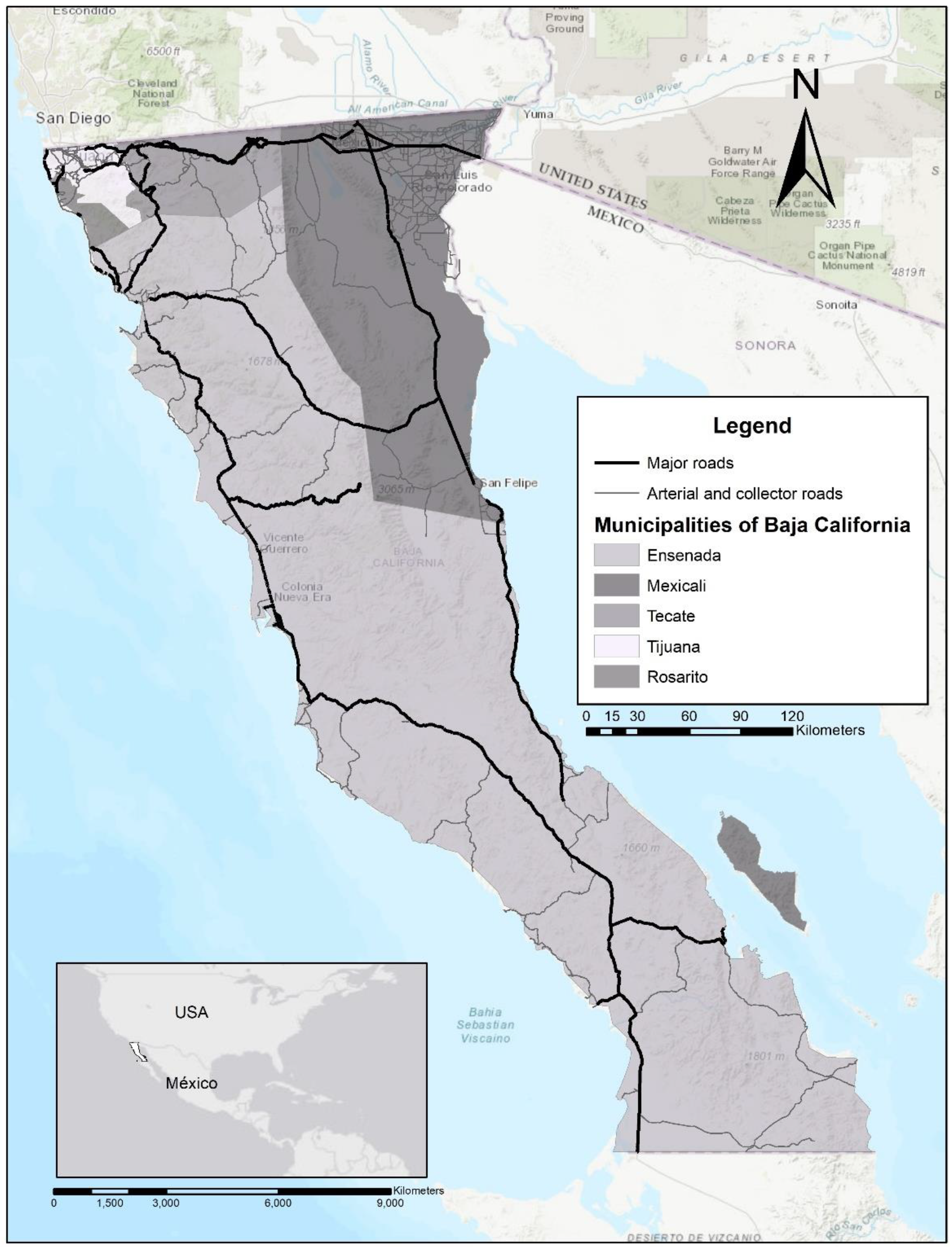

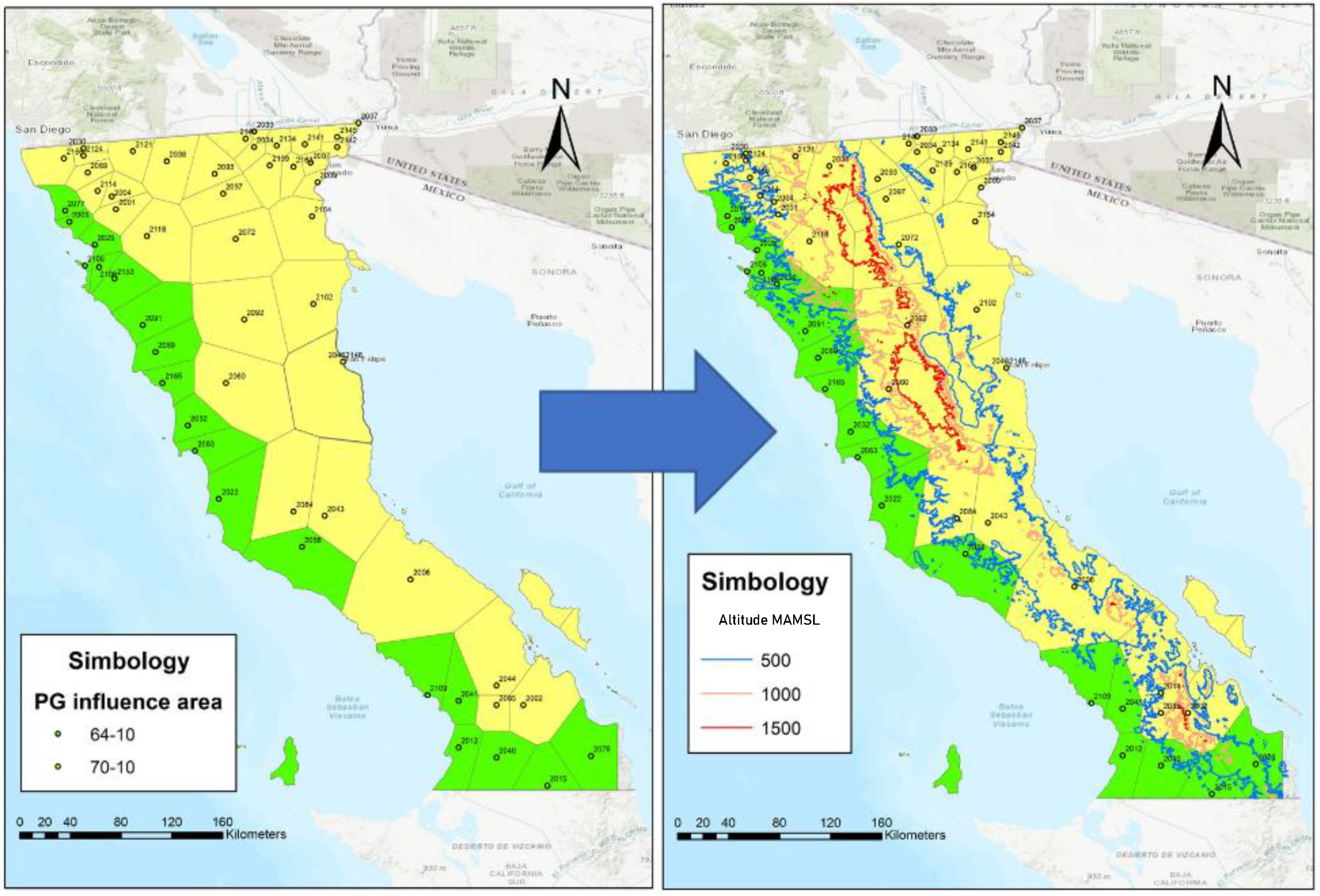



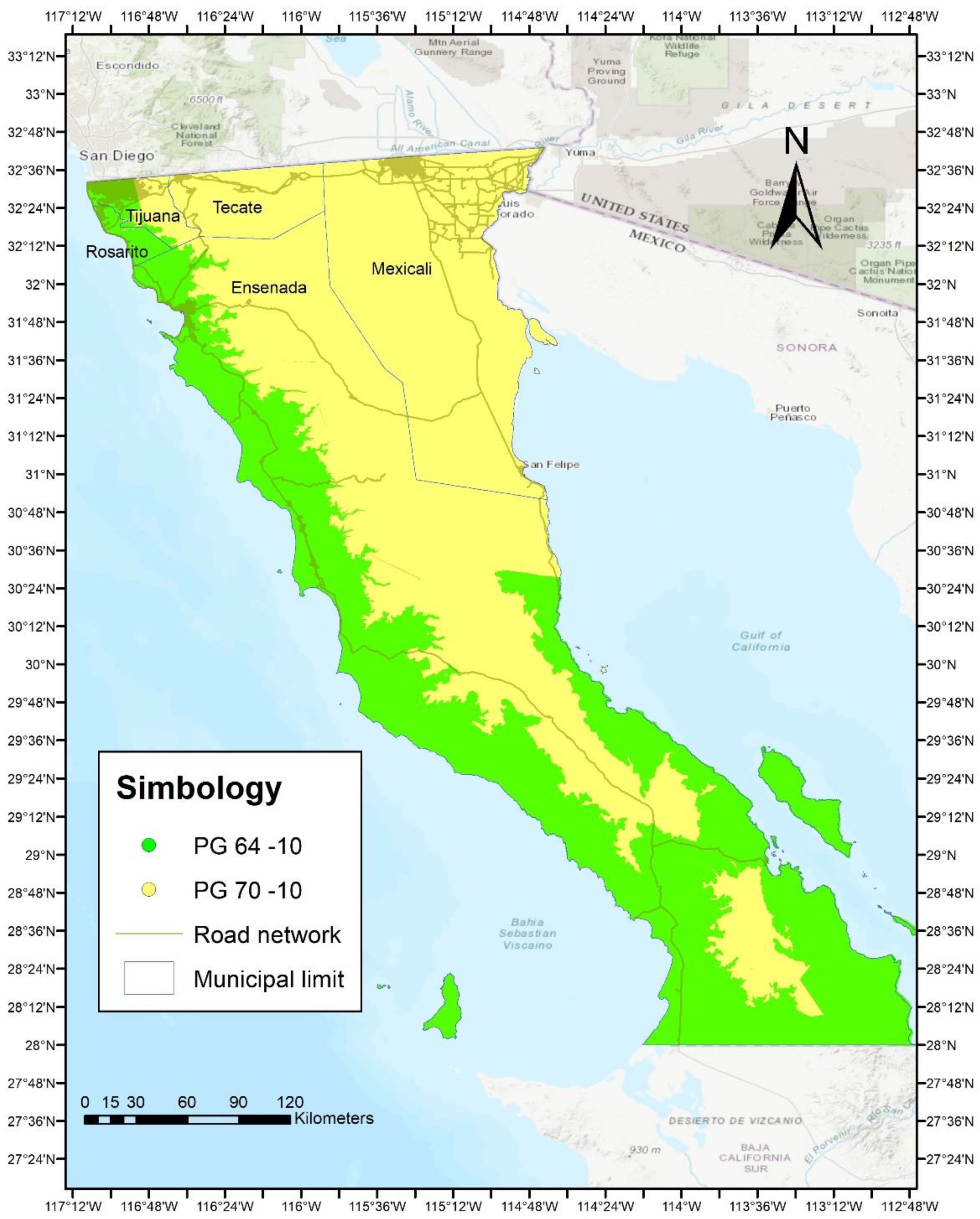
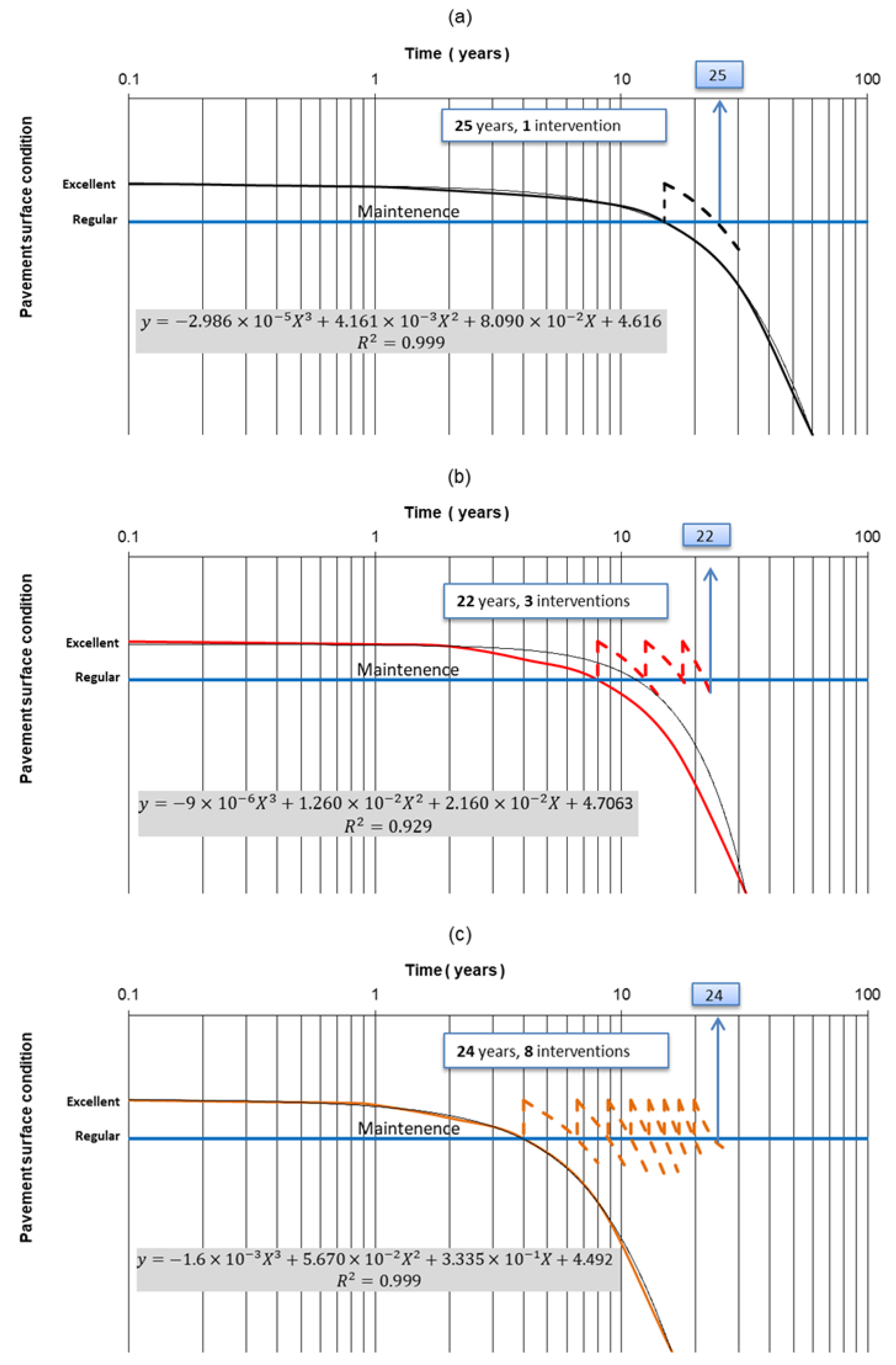
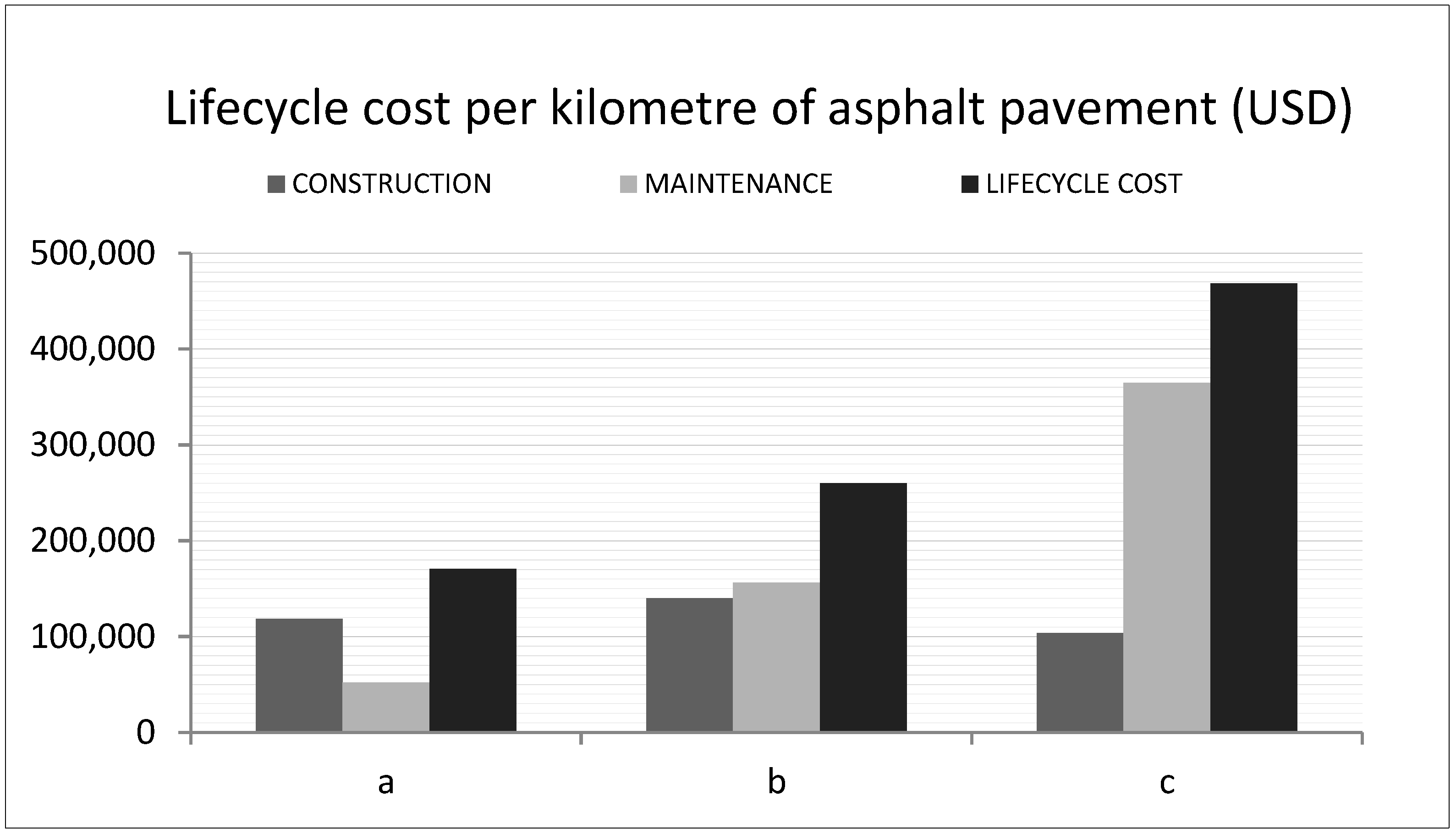
Publisher’s Note: MDPI stays neutral with regard to jurisdictional claims in published maps and institutional affiliations. |
© 2022 by the authors. Licensee MDPI, Basel, Switzerland. This article is an open access article distributed under the terms and conditions of the Creative Commons Attribution (CC BY) license (https://creativecommons.org/licenses/by/4.0/).
Share and Cite
Cota, J.; Martínez-Lazcano, C.; Montoya-Alcaraz, M.; García, L.; Mungaray-Moctezuma, A.; Sánchez-Atondo, A. Improvement in Durability and Service of Asphalt Pavements through Regionalization Methods: A Case Study in Baja California, Mexico. Sustainability 2022, 14, 5123. https://doi.org/10.3390/su14095123
Cota J, Martínez-Lazcano C, Montoya-Alcaraz M, García L, Mungaray-Moctezuma A, Sánchez-Atondo A. Improvement in Durability and Service of Asphalt Pavements through Regionalization Methods: A Case Study in Baja California, Mexico. Sustainability. 2022; 14(9):5123. https://doi.org/10.3390/su14095123
Chicago/Turabian StyleCota, José, Cynthia Martínez-Lazcano, Marco Montoya-Alcaraz, Leonel García, Alejandro Mungaray-Moctezuma, and Alejandro Sánchez-Atondo. 2022. "Improvement in Durability and Service of Asphalt Pavements through Regionalization Methods: A Case Study in Baja California, Mexico" Sustainability 14, no. 9: 5123. https://doi.org/10.3390/su14095123
APA StyleCota, J., Martínez-Lazcano, C., Montoya-Alcaraz, M., García, L., Mungaray-Moctezuma, A., & Sánchez-Atondo, A. (2022). Improvement in Durability and Service of Asphalt Pavements through Regionalization Methods: A Case Study in Baja California, Mexico. Sustainability, 14(9), 5123. https://doi.org/10.3390/su14095123







